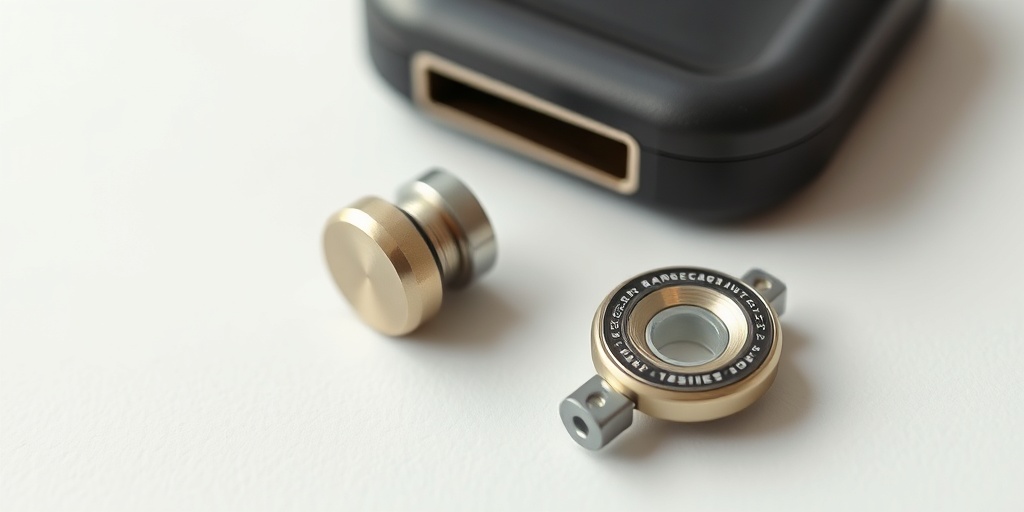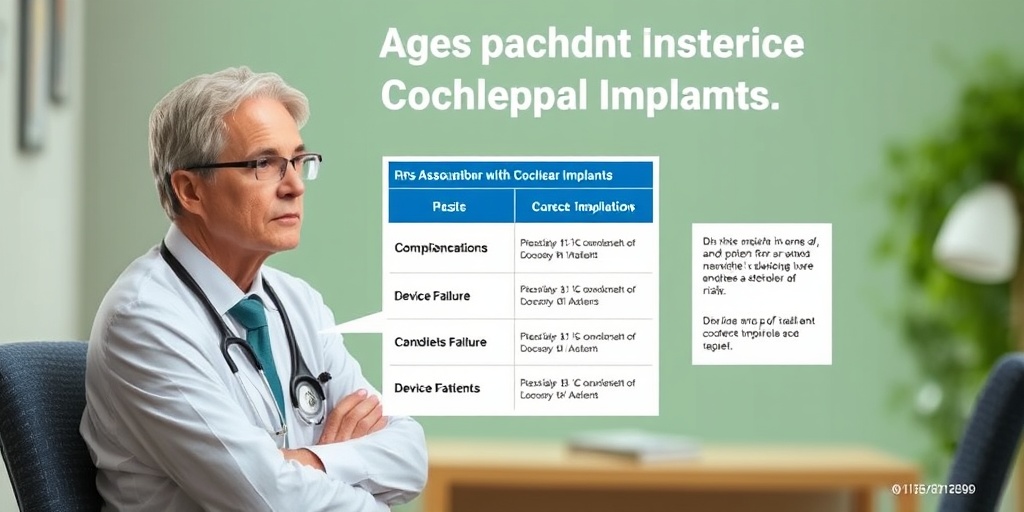What Are Cochlear Implants?
Cochlear implants are remarkable medical devices designed to provide a sense of sound to individuals who are profoundly deaf or severely hard of hearing. Unlike traditional hearing aids, which amplify sound, cochlear implants bypass damaged portions of the ear and directly stimulate the auditory nerve. This innovative technology has transformed the lives of many, allowing them to experience sounds they may have never heard before.
The meaning of cochlear implants lies in their ability to restore hearing through a surgical procedure. The device consists of two main components: an external processor worn behind the ear and an internal implant surgically placed under the skin. Together, they work to convert sound waves into electrical signals that the brain can interpret as sound.
Who Can Benefit from Cochlear Implants?
Cochlear implants are suitable for a variety of individuals, including:
- Adults with severe to profound hearing loss who do not benefit from hearing aids.
- Children with significant hearing loss, especially those who have not developed speech and language skills.
- Individuals with auditory neuropathy or other specific types of hearing loss.
It’s essential to consult with an audiologist or an ear, nose, and throat (ENT) specialist to determine if cochlear implants are the right option for you or your loved one. They will conduct thorough evaluations to assess hearing ability and overall health.
How Do Cochlear Implants Work?
The functioning of cochlear implants can be broken down into several key steps:
- Sound Collection: The external microphone picks up sounds from the environment.
- Sound Processing: The processor converts these sounds into digital signals.
- Signal Transmission: The signals are sent to the internal implant via a transmitter.
- Nerve Stimulation: The implant stimulates the auditory nerve, sending signals to the brain.
This process allows users to perceive sounds, recognize speech, and engage in conversations, significantly improving their quality of life. 🎶
Cochlear Implant Components
Cochlear implants consist of two primary components that work together to facilitate hearing:
1. External Components
The external part of the cochlear implant includes:
- Microphone: Captures sound from the environment.
- Speech Processor: Analyzes and converts sound into a digital signal.
- Transmitter: Sends the processed signals to the internal implant.
These components are typically worn behind the ear and are designed to be discreet and comfortable for daily use.
2. Internal Components
The internal components are surgically implanted and include:
- Receiver: Receives signals from the external transmitter.
- Electrode Array: A series of electrodes that are inserted into the cochlea to stimulate the auditory nerve directly.
The surgical procedure to implant these components is generally safe and performed under general anesthesia. Recovery times can vary, but many individuals can return to their daily activities relatively quickly.
Pros and Cons of Cochlear Implants
Like any medical intervention, cochlear implants come with their own set of advantages and disadvantages:
- Pros:
- Improved ability to hear and understand speech.
- Enhanced social interactions and communication.
- Access to a wider range of sounds, including music.
- Cons:
- Requires surgery, which carries inherent risks.
- Not all individuals experience the same level of success.
- May require ongoing therapy and adjustment.
For those considering cochlear implants, it’s crucial to weigh these factors carefully. Consulting with healthcare professionals can provide valuable insights tailored to individual needs.
In conclusion, cochlear implants represent a significant advancement in hearing technology, offering hope and improved quality of life for many individuals with hearing loss. If you’re interested in learning more about cochlear implants or exploring your options, resources like Yesil Health AI (yesilhealth.com) can provide evidence-based answers to your questions. 🌟

Cochlear Implant Candidates
Cochlear implants are revolutionary devices that can significantly improve the quality of life for individuals with severe to profound hearing loss. However, not everyone is a suitable candidate for this procedure. Understanding who qualifies for cochlear implants is crucial for those considering this option. Let’s explore the key factors that determine candidacy for cochlear implants.
Understanding Hearing Loss
The first step in determining candidacy is understanding the type and degree of hearing loss. Cochlear implants are typically recommended for individuals who:
- Have severe to profound sensorineural hearing loss in both ears.
- Do not benefit adequately from traditional hearing aids.
- Are at least 12 months old (for children) or older (for adults).
Sensorineural hearing loss occurs when there is damage to the inner ear or the auditory nerve, making it difficult for sound signals to reach the brain. If you or a loved one is experiencing significant hearing challenges, consulting with an audiologist can help determine the specific type of hearing loss.
Medical Evaluation
Before proceeding with cochlear implant surgery, candidates must undergo a thorough medical evaluation. This evaluation typically includes:
- A comprehensive hearing test to assess the degree of hearing loss.
- Imaging tests, such as a CT scan or MRI, to evaluate the structure of the inner ear.
- An assessment of overall health to ensure the patient can safely undergo surgery.
These evaluations help healthcare professionals determine if cochlear implants are a viable option and if any underlying medical conditions could complicate the procedure.
Age and Developmental Considerations
Age plays a significant role in candidacy for cochlear implants. For children, early intervention is crucial. Research suggests that children who receive cochlear implants before the age of two tend to have better language development outcomes. However, adults can also benefit significantly from cochlear implants, especially if they have experienced a recent decline in hearing.
In addition to age, developmental considerations are essential for children. Parents should consider whether their child is ready to engage in the rehabilitation process that follows implantation, which includes speech therapy and auditory training.
Realistic Expectations
It’s important for candidates to have realistic expectations about the outcomes of cochlear implants. While many individuals experience significant improvements in their ability to hear and understand speech, results can vary. Factors influencing outcomes include:
- The duration of hearing loss prior to implantation.
- The age at which the individual lost their hearing.
- The presence of other medical conditions.
Having open discussions with healthcare providers about potential outcomes can help candidates prepare for the journey ahead.
Cochlear Implant Surgery
Cochlear implant surgery is a significant step for those seeking to regain their hearing. Understanding the procedure, recovery, and what to expect can help alleviate anxiety and prepare candidates for this life-changing experience.
The Surgical Procedure
Cochlear implant surgery is typically performed on an outpatient basis and lasts about two to four hours. Here’s a brief overview of the process:
- Anesthesia: The patient is given general anesthesia to ensure comfort during the procedure.
- Incision: A small incision is made behind the ear to access the inner ear.
- Implant Placement: The cochlear implant’s internal components are carefully placed in the cochlea, the spiral-shaped organ responsible for hearing.
- Closure: The incision is then closed with sutures, and the patient is monitored as they wake up from anesthesia.
Most patients can go home the same day, but it’s essential to have someone available to assist with transportation and care post-surgery.
Recovery and Rehabilitation
After surgery, patients will need time to recover. Here’s what to expect during the recovery phase:
- Initial Healing: The surgical site may be sore, and patients are advised to avoid strenuous activities for a few weeks.
- Activation: The cochlear implant is typically activated about two to four weeks post-surgery, allowing the patient to begin hearing sounds.
- Rehabilitation: Ongoing auditory training and speech therapy are crucial for maximizing the benefits of the implant.
Recovery is a gradual process, and patience is key. Many individuals report significant improvements in their hearing abilities over time as they adapt to their new device.
Potential Risks and Considerations
As with any surgical procedure, there are risks associated with cochlear implant surgery. These may include:
- Infection at the surgical site.
- Device malfunction or failure.
- Changes in taste or facial nerve damage (rare).
Discussing these risks with a healthcare provider can help candidates make informed decisions about proceeding with surgery.
Cochlear implants can be a transformative solution for those with hearing loss, offering the potential for improved communication and a better quality of life. If you or someone you know is considering cochlear implants, understanding candidacy and the surgical process is the first step toward a brighter auditory future. 🌟

Cochlear Implant Benefits
Cochlear implants are revolutionary devices that can significantly improve the quality of life for individuals with severe hearing loss. Unlike traditional hearing aids, which amplify sound, cochlear implants bypass damaged portions of the ear and directly stimulate the auditory nerve. Here are some of the key benefits of cochlear implants:
1. Enhanced Hearing Ability
One of the most significant advantages of cochlear implants is the ability to restore hearing. Many recipients report improved understanding of speech, even in noisy environments. This enhancement allows individuals to engage more fully in conversations and social interactions, leading to a more fulfilling life.
2. Improved Quality of Life
With better hearing comes a better quality of life. Cochlear implants can help individuals reconnect with family and friends, participate in community activities, and enjoy music and other auditory experiences. This social reintegration can lead to increased self-esteem and emotional well-being.
3. Accessibility to Sounds
Cochlear implants provide access to a wider range of sounds, including environmental noises that many people take for granted. From the chirping of birds to the sound of laughter, these devices help users experience the world around them in a richer way. 🌍
4. Educational Advantages for Children
For children with hearing loss, cochlear implants can be particularly beneficial. Early implantation can lead to improved language development and academic performance. Children with cochlear implants often have better outcomes in speech and language skills compared to those who rely solely on hearing aids.
5. Long-Term Cost-Effectiveness
While the cost of cochlear implants can be significant upfront, they may prove to be more cost-effective in the long run. Unlike hearing aids, which need regular replacements and maintenance, cochlear implants are designed to last for many years, reducing the need for ongoing expenses.
Cochlear Implant Risks
While cochlear implants offer numerous benefits, it is essential to consider the potential risks and drawbacks associated with the procedure. Understanding these risks can help individuals make informed decisions about their hearing health.
1. Surgical Risks
As with any surgical procedure, cochlear implantation carries inherent risks. These may include complications such as infection, bleeding, or adverse reactions to anesthesia. It’s crucial for candidates to discuss these risks with their healthcare provider before proceeding.
2. Device Malfunction
Cochlear implants are sophisticated devices that can occasionally malfunction. Issues may arise due to hardware failure or external factors, such as moisture exposure. Regular follow-ups with an audiologist are necessary to ensure the device is functioning correctly.
3. Adjustment Period
After receiving a cochlear implant, users often experience an adjustment period. The brain needs time to adapt to the new sounds it receives, which can be overwhelming at first. Some individuals may find it challenging to interpret sounds accurately during this phase.
4. Limited Benefit for Some
Not everyone is a suitable candidate for cochlear implants. Individuals with certain types of hearing loss or those who have not benefited from previous hearing aids may find that cochlear implants do not provide the expected level of improvement. It’s essential to undergo thorough evaluations to determine candidacy.
5. Potential for Tinnitus
Some individuals may experience tinnitus, or ringing in the ears, after receiving a cochlear implant. While this is not universal, it can be distressing for those affected. In some cases, cochlear implants have been used to help manage tinnitus, but results can vary widely.
In conclusion, cochlear implants offer a range of benefits that can significantly enhance the lives of those with hearing loss. However, it is equally important to weigh these benefits against the potential risks. Consulting with healthcare professionals can provide valuable insights and help individuals make the best choice for their hearing health. 🦻✨

Cochlear Implant Rehabilitation
Cochlear implants are revolutionary devices that can significantly improve the quality of life for individuals with severe hearing loss. However, the journey doesn’t end with the surgical procedure; rehabilitation is a crucial step in maximizing the benefits of cochlear implants. This process involves various strategies and therapies designed to help users adapt to their new hearing capabilities.
Understanding Cochlear Implant Rehabilitation
Rehabilitation for cochlear implant users typically begins shortly after the device is activated. The goal is to help individuals learn how to interpret the sounds they hear through their implants. This process can be challenging, as the auditory signals received may be different from what they experienced before.
Key Components of Rehabilitation
- Audiological Therapy: Working with an audiologist, patients engage in exercises that focus on sound discrimination, speech reading, and auditory memory.
- Speech Therapy: Speech-language pathologists help users improve their communication skills, focusing on articulation and language comprehension.
- Family Involvement: Involving family members in the rehabilitation process can enhance support and create a more conducive environment for learning.
- Group Therapy: Participating in group sessions can provide social interaction and help users practice their listening skills in a supportive setting.
Setting Realistic Goals
It’s essential for cochlear implant users to set realistic goals during their rehabilitation journey. Progress may vary from person to person, and patience is key. Regular follow-ups with healthcare professionals can help track improvements and adjust rehabilitation strategies as needed.
Technology and Resources
Many resources are available to assist in cochlear implant rehabilitation. From mobile apps that provide auditory training exercises to online support groups, technology plays a significant role in enhancing the rehabilitation experience. Users can also access educational materials that explain the workings of cochlear implants and offer tips for effective communication.
Cochlear Implant Maintenance
Maintaining your cochlear implant is vital for ensuring its longevity and optimal performance. Proper care can prevent issues and enhance the overall experience of using the device. Here are some essential maintenance tips to keep in mind.
Daily Care Routine
Establishing a daily care routine is crucial for cochlear implant users. Here are some steps to follow:
- Cleaning: Regularly clean the external components of the cochlear implant, including the microphone and processor, to remove dirt and moisture.
- Battery Management: Ensure that batteries are replaced regularly and check for any signs of corrosion in the battery compartment.
- Moisture Protection: Use protective covers or dehumidifiers to safeguard the device from moisture, especially in humid environments.
Periodic Check-Ups
Regular check-ups with your audiologist are essential for monitoring the performance of your cochlear implant. These appointments allow for:
- Device Adjustments: Audiologists can fine-tune the settings of the cochlear implant to optimize sound quality.
- Software Updates: Keeping the device’s software up to date ensures that users benefit from the latest advancements in technology.
- Hearing Assessments: Regular hearing assessments help track progress and determine if further rehabilitation is needed.
Understanding Potential Issues
Being aware of potential issues can help users address problems before they escalate. Common concerns include:
- Sound Distortion: If sounds become distorted, it may indicate a need for adjustment or maintenance.
- Battery Life: If the battery drains quickly, it could signal a malfunction or the need for a replacement.
- Physical Damage: Regularly inspect the device for any signs of wear and tear, especially after physical activities.
Resources for Maintenance
Many manufacturers provide resources and support for cochlear implant maintenance. Users can access user manuals, online tutorials, and customer service for assistance. Additionally, joining support groups can offer valuable insights and tips from fellow cochlear implant users.
By prioritizing rehabilitation and maintenance, cochlear implant users can significantly enhance their hearing experience and overall quality of life. 🌟

Frequently Asked Questions about Cochlear Implants
What are Cochlear Implants?
Cochlear implants are electronic devices designed to provide a sense of sound to individuals with severe to profound hearing loss. Unlike hearing aids, which amplify sound, cochlear implants bypass damaged portions of the ear and directly stimulate the auditory nerve.
How do Cochlear Implants work?
The device consists of two main components: an external processor that captures sound and a surgically implanted internal component that converts sound into electrical signals. These signals are then sent to the auditory nerve, allowing the brain to perceive sound.
Who is a candidate for Cochlear Implants?
Individuals with severe to profound hearing loss who do not benefit from traditional hearing aids may be candidates for cochlear implants. A thorough evaluation by an audiologist and an ear, nose, and throat (ENT) specialist is necessary to determine eligibility.
What is the cost of Cochlear Implants?
The cost of cochlear implants can vary significantly based on factors such as the type of device, surgical fees, and rehabilitation services. Many insurance plans cover a portion of the costs, so it’s essential to check with your provider for specific coverage details.
Cochlear Implants vs Hearing Aids: What’s the Difference?
While both cochlear implants and hearing aids assist individuals with hearing loss, they function differently. Hearing aids amplify sound, while cochlear implants convert sound into electrical signals for direct stimulation of the auditory nerve. The choice between the two depends on the severity of hearing loss and individual needs.
Can Cochlear Implants help with Tinnitus?
Some individuals with tinnitus may find relief through cochlear implants, as the device can help restore auditory input. However, results can vary, and it is essential to discuss this with a healthcare professional to understand the potential benefits.
Are there any risks associated with Cochlear Implants?
As with any surgical procedure, there are risks involved, including infection, device malfunction, and changes in taste. It is crucial to have a detailed discussion with your healthcare provider about the potential risks and benefits before proceeding.
Can I get an MRI with Cochlear Implants?
Individuals with cochlear implants can undergo MRI scans, but specific precautions must be taken. It is essential to inform the MRI technician about the implant, as certain types of scans may require special settings or equipment.
Where can I find Cochlear Implants near me?
To find cochlear implant services in your area, consult with local audiologists, ENT specialists, or hospitals that offer hearing loss treatments. Online directories and health care websites can also provide information on nearby facilities.
What are the pros and cons of Cochlear Implants?
- Pros: Improved hearing ability, better communication, and enhanced quality of life.
- Cons: Surgical risks, potential for device failure, and the need for ongoing therapy and adjustments.
How long does the Cochlear Implant surgery take?
The surgical procedure for cochlear implants typically lasts between 2 to 4 hours. After surgery, patients usually stay in the hospital for a short period for monitoring and recovery.
What is the recovery process like after Cochlear Implant surgery?
Recovery from cochlear implant surgery varies by individual but generally includes a few days of rest and gradual resumption of normal activities. Follow-up appointments will be necessary for device activation and adjustments.




